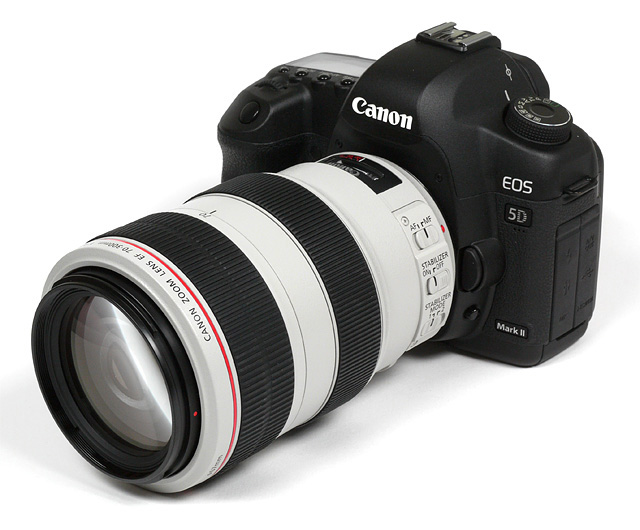|
Canon EF 70-300mm f/4-5.6 USM L IS - Full Format Review / Test Report |
|
Lens Reviews -
Canon EOS (Full Format)
|
|
Page 1 of 3

Review by Klaus Schroiff, published December 2010
Introduction
The Canon EF 70-300mm f/4-5.6 USM L IS is the latest addition to Canon's tele zoom lens lineup making it, by far, the most extensive system in this segment. Canon offers no less than SIX (!) ~300mm zoom lenses which makes you wonder whether their marketing folks went nuts altogether. :-) Just to give you an idea, Nikon and Sony offer only two options here. Anyway, this is good news for you, of course, because there's another alternative to choose from. The EF 70-300mm USM L IS is the top-of-the-line L-class ("Luxury") model here thus a professional grade product. This is probably where the headaches start for most of us because Canon asks no less than ~1500EUR/US$ for the lens. This is actually more than for the, admittedly quite old, EF 100-400mm f/4.5-5.6 USM L IS.
 The build quality of the lens is nothing short of outstanding - that's probably the very first time for me to praise a ~300mm zoom lens like this. The lens body is made of metal and everything is tightly assembled and also sealed against dust and humidity. The inner lens tube (also made of metal) extends when zooming towards the long end but there's not even the slightest hint of wobbling here. The focus ring operates silky and the zoom ring feels very smooth as well.
There's a transport lock (70mm setting) in order to prevent zoom creeping but our sample showed no tendency to do so anyway. The front element does not rotate during focus operations so using a polarizer remains easily possible. The lens does not feature a dedicated tripod mount straight from the factory but it is an optional accessory.
The build quality of the lens is nothing short of outstanding - that's probably the very first time for me to praise a ~300mm zoom lens like this. The lens body is made of metal and everything is tightly assembled and also sealed against dust and humidity. The inner lens tube (also made of metal) extends when zooming towards the long end but there's not even the slightest hint of wobbling here. The focus ring operates silky and the zoom ring feels very smooth as well.
There's a transport lock (70mm setting) in order to prevent zoom creeping but our sample showed no tendency to do so anyway. The front element does not rotate during focus operations so using a polarizer remains easily possible. The lens does not feature a dedicated tripod mount straight from the factory but it is an optional accessory.
 The ring-type USM AF is blazingly fast and near silent. FTM, full-time manual focusing, is possible in one-shot AF mode. LiveView-(contrast)-AF is reasonably fast. The AF accuracy of our test sample was very high. Just like most Canon tele lenses it features an image stabilizer (IS) which is supposed to give you an extra potential of up to 4 f-stops. You should take this with a little grain of salt but it seems to come quite close actually. Unlike the consumer variants the IS system has 2 modes - a normal one for static shooting (horizontal + vertical stabilization) and a panning mode (horizontal OR vertical stabilization - the panning direction is automatically detected). The IS also supports tripod detection so it can remain activated here.
Here's a comparison with its nearest cousins:
The ring-type USM AF is blazingly fast and near silent. FTM, full-time manual focusing, is possible in one-shot AF mode. LiveView-(contrast)-AF is reasonably fast. The AF accuracy of our test sample was very high. Just like most Canon tele lenses it features an image stabilizer (IS) which is supposed to give you an extra potential of up to 4 f-stops. You should take this with a little grain of salt but it seems to come quite close actually. Unlike the consumer variants the IS system has 2 modes - a normal one for static shooting (horizontal + vertical stabilization) and a panning mode (horizontal OR vertical stabilization - the panning direction is automatically detected). The IS also supports tripod detection so it can remain activated here.
Here's a comparison with its nearest cousins:
|
Canon
EF 70-300mm f/4.5-5.6
USM DO IS |
Canon
EF 70-300mm f/4-5.6
USM IS |
Canon
EF 70-300mm f/4-5.6
USM L IS |
| design: |
18 elements in 12 groups, 1x DO element |
15 elements in 10 groups, 1x UD element |
19 elements in 14 groups, 2x UD elements, floating system |
| size: |
82x100mm |
77x143mm |
89x143mm |
| weight: |
720g |
630g |
1050g |
| image stabilizer efficiency: |
3 f-stops, 2 modes |
3 f-stops, 2 modes |
4 f-stops, 2 modes |
| aperture blades: |
6 |
8 |
8 (circular) |
| min. focus: |
1.4m |
1.5m |
1.2m |
| filter size: |
58mm |
58mm |
67mm |
| AF motor |
ring-type USM with FTM and non-rotating front element |
micro-USM, no FTM, rotating front element |
ring-type USM with FTM and non-rotating front element |
| sealing |
no |
no |
yes |
| approx price tag: |
1200 EUR/US$ |
450 EUR/US$ |
1500 EUR/US$ |
|